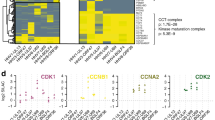Abstract
G1 cyclin E controls the initiation of DNA synthesis by activating CDK2, and abnormally high levels of cyclin E expression have frequently been observed in human cancers. We have isolated a novel human cyclin, cyclin E2, that contains significant homology to cyclin E. Cyclin E2 specifically interacts with CDK inhibitors of the CIP/KIP family and activates both CDK2 and CDK3. The expression of cyclin E2 mRNA oscillates periodically throughout the cell cycle, peaking at the G1/S transition, and exhibits a pattern of tissue specificity distinct from that of cyclin E1. Cyclin E2 encodes a short lived protein whose turnover is most likely governed by the proteasome pathway and is regulated by phosphorylation on a conserved Thr-392 residue. Expression of the viral E6 oncoprotein in normal human fibroblasts increases the steady state level of cyclin E2, but not cyclin E1, while expression of the E7 oncoprotein upregulates both. These data suggest that the expression of these two G1 E-type cyclins may be similarly regulated by the pRb function, but distinctly by the p53 activity.
Similar content being viewed by others
Author information
Authors and Affiliations
Rights and permissions
About this article
Cite this article
Zariwala, M., Liu, J. & Xiong, Y. Cyclin E2, a novel human G1 cyclin and activating partner of CDK2 and CDK3, is induced by viral oncoproteins. Oncogene 17, 2787–2798 (1998). https://doi.org/10.1038/sj.onc.1202505
Received:
Revised:
Accepted:
Published:
Issue Date:
DOI: https://doi.org/10.1038/sj.onc.1202505
- Springer Nature Limited
Keywords
This article is cited by
-
Chemopreventive effects of pterostilbene through p53 and cell cycle in mouse lung of squamous cell carcinoma model
Scientific Reports (2021)
-
Joint changes in RNA, RNA polymerase II, and promoter activity through the cell cycle identify non-coding RNAs involved in proliferation
Scientific Reports (2021)
-
Two unique HLA-A*0201 restricted peptides derived from cyclin E as immunotherapeutic targets in leukemia
Leukemia (2020)
-
Transcribed ultraconserved region 339 promotes carcinogenesis by modulating tumor suppressor microRNAs
Nature Communications (2017)
-
MicroRNA-15a inhibits the growth and invasiveness of malignant melanoma and directly targets on CDCA4 gene
Tumor Biology (2016)




